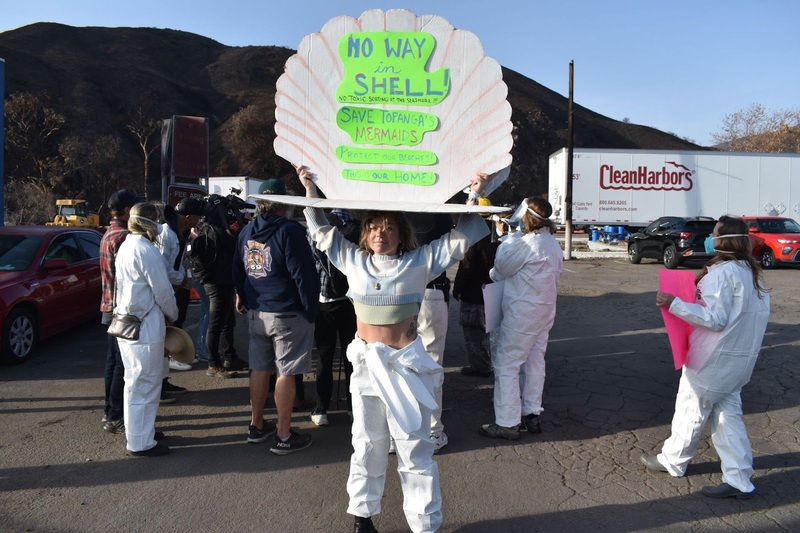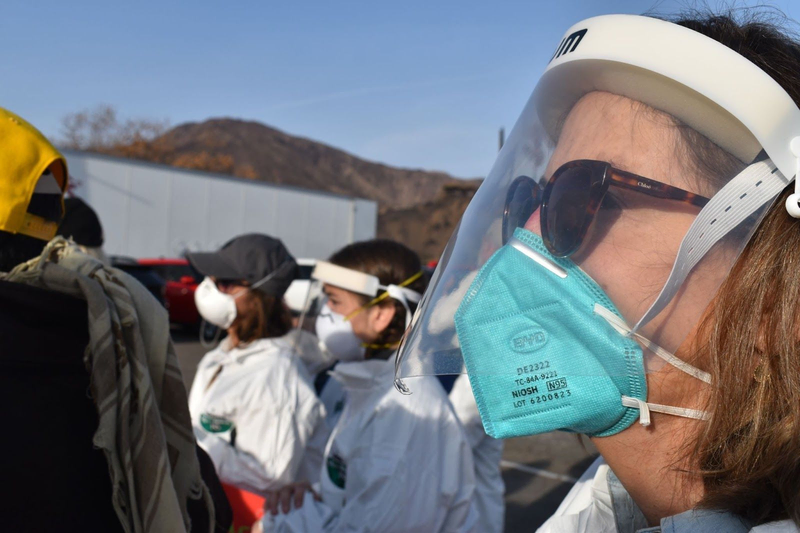A modest but motivated crowd gathered by Topanga Beach on Friday afternoon to protest the decision to place a sorting site for toxic and contaminated debris cleared from the Palisades Fire where the Topanga Ranch Motel used to be.
Located next to Topanga Canyon Lane and straddling the Creek, the site is adjacent to where the popular Reel Inn seafood diner was, on the east side of the Pacific Coast Highway. Approximately 30 protesters gathered, with almost as many members of the media, to make their feeling known to officials from the Environmental Protection Agency (EPA).
The EPA announced the staging area will operate 24/7 for up to three months as crews process dangerous materials collected from fire-damaged properties. The site, part of Topanga State Park and previously slated for a lagoon restoration project, will serve as a controlled facility where hazardous materials can be "safely processed, sorted, and packaged" before disposal, according to California State Parks officials.
One of the primary concerns is that any risk of leak equates to toxic materials leaking into the creek and flowing freely into the ocean. Topanga Creek drains Topanga Canyon and is the third largest watershed entering the Santa Monica Bay. However, since all vegetation in the surrounding hills and mountains has burned, there is little left to hold the soil together. Consequently, the danger of catastrophic mudslides is real to residents in the nearby neighborhoods and so is the potential spread of these toxic contaminants.
Many items typically found in homes contain chemicals and materials that will produce toxic fumes and residuals when burnt. Televisions, laptops, solar panels and in fact just about anything electronic, batteries, cars and electric vehicles all contain components that are made from materials that present a contamination danger after being utterly incinerated. And then there’s the asbestos, which still exists in many houses built between 1930 and 1950.
A call to action email was sent to residents and posted on social media towards the end of last week encouraging anyone with a vested interest to come along and make their thoughts and feelings known. And while the number wasn’t massive, the presence of just about every media outlet offered some reassurance that the message would at least be heard.
Interestingly, the EPA originally wanted to set this facility up at Will Rogers Beach, but that was denied for reasons that not even the EPA are totally sure about. However, that doesn’t offer much consultation to the residents of Topanga Canyon.
“That land is closer to the Palisades, less risk of a problem, away from the creek, away from the wind, away from the ocean, closer to the material. Why can't it be done right in the Palisades?” asked local resident Chad White.
Much of the objection was the fact that this site, outside of the City of Los Angeles, was having to take the debris from Palisades Village, which is inside the city boundary.
“This is a protected area. We kicked people out of here 20 years ago because it was too much for them to live on the watershed. Now you're telling me that we can bring all this crap here. I doubt they said that for Will Rogers, it's not the same story. So we all have to take our share. I'll take the share of what happened here and what happened up there, one hundred percent, but I'm not taking the Palisades, no,” said local resident Carolyn Day.
“This is LA County. We'll take the county. Okay? I understand the struggle, we all shared resources … but it is their stuff, and they do have a huge amount of area available. I bet you guys would love to use that space [Will Rogers]. It's huge. It's eight times the size of this … This is a flood zone. What's your plan if this area floods?” asked White.
Additional concerns included the additional congestion that the constant movement of heavy vehicles would create on the PCH, when it finally opens.
Attempting to respond to everyone’s objections was Rusty Harris-Bishop, California Site Cleanup Section Manager for the EPA. Talking exclusively to the Daily Press, Harris-Bishop said, “These people have a passion for their community, and they feel that they weren't involved in the decision making process.”
“What we've done already is we've cleared the burned areas that were destroyed in the fires. We brought in gravel to level it. We're going to be putting in pads, where we put a multi layer of material so that we can have a stable place to work that's lined with wattles, so that we can prevent anything from washing on or washing off the property of that pad,” Harris-Bishop explained.
“We're going to then bring those materials from the burned area on those trucks, they're going to come in here and be unloaded by our staff that work here, and then those are going to be the materials that we've collected are then going to be put into larger containers that are appropriate for shipping to disposal facilities.”
He stressed that every precaution was being taken to ensure that the operation goes smoothly and that the materials are being transported in sealed containers on trucks.
When asked why this particular site was chosen, Harris-Bishop said, “I don't know all the details. Basically, we work with the state, FEMA LA County and the surrounding cities to respond to the fires and how we're going to do this recovery and rebuilding.
“We wanted Will Rogers. We were denied initially … I don't know the interior discussions about that, but we're still working on them. For the Eaton fire, we're looking at the Rose Bowl, Santa Anita Raceway. When we got here and started this work, they were still full. They were being used by emergency vehicles from Cal Fire and from the utility companies, because there's a lot of work going on.
“There are a lot of large vehicles and equipment being staged all over the county to respond to this. And so we need our space as well, but there are other people who were here first fighting the fire. So as those open up, we're hoping that we can move into some of them.”











